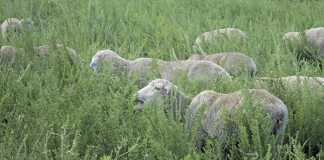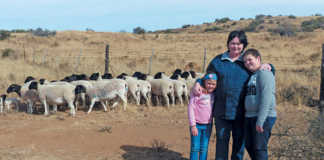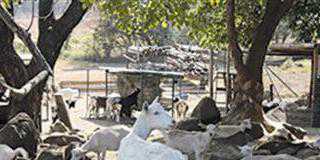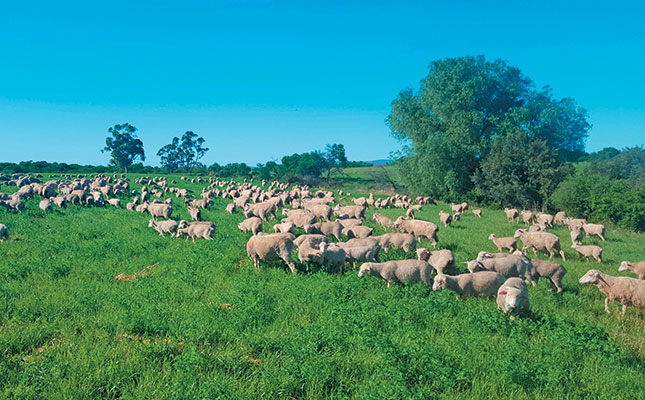
Photo: Courtesy of the Van Aardt family
“The Fairworld philosophy is a 103-year-old process of eliminating the non-producers year after year,’’ says Willem van Aardt, describing genetic development in his family’s legendary Merino stud.
“Every generation has been steering the ship in the same direction, giving us the edge.’’
The Van Aardt family can today look back at over a century of consistent achievements
in the Merino stud world, including numerous South African Fine and Super Fine Champion fleeces, a World Champion Super Fine Wool Fleece, and South African record prices for Merino rams.
Willem began working on the family farm Roodewal in 1969. After his father Acton died in 1976, he and his brother Carlie each inherited half of the family’s Merino flock.
Both went on to build two exceptional fine wool studs – the Fairworld and Baviaanskrans studs – thanks largely to their father’s lifelong dedication to fine wool. “He always said you can do anything with fine wool,’’ recalls Willem,“ but that you can’t do anything with strong wool.’’
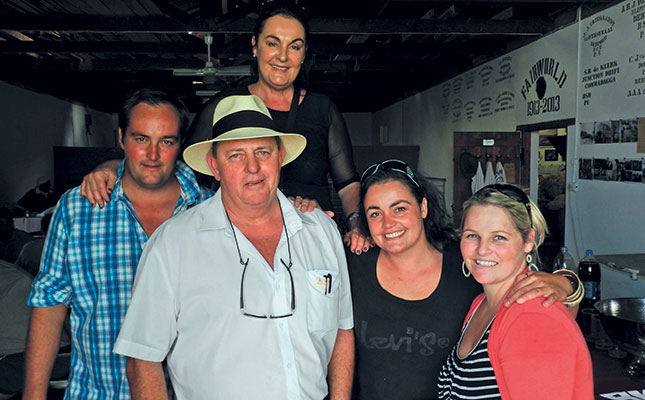
Willem’s grandfather, Carel van Aardt, registered the Fairworld Merino Stud on 12 December 1913. Less than two months previously, he had acquired 400 Bundemar Merino ewes from the local Vosloo and Triegaardt families.
The introduction of Merinos to Roodewal was partly a result of the Anglo-Boer War (1899-1902).
Carel, a respected horse breeder, was ruined when the British confiscated 350 brood mares and interned him.
When he returned to the farm after the war, he found only a few milk cows and a handful of slaughter sheep. Undeterred, he set out reinventing himself by producing butter and introducing livestock, including goats and ostriches.
By 1910, he was wealthy enough to loan money to neighbours and three years later bought his first Merinos.
The first Roodewal wool bales were delivered to the Cookhouse station on 20 October 1914, and the first Van Aardt wool cheque of £95 (about R116 000 today) was banked in January 1915.
Unprecedented heights
Carel’s son Acton served with the 8th SA Infantry Battalion during the First World War. He returned to the farm in 1916 and by 1919 had taken full responsibility for Roodewal’s Merinos, selling the first ram to a farmer in the Rouxville district in the southern Free State.
Success came soon; he broke the South African wool price record in 1922, a feat he was to repeat two years later and a number of times after that. These were important achievements for the fledgling stud, according to Willem.
“Today, you give facts and figures about rams and buy accordingly. In those days, the farmer who sold his wool for the highest price was understood to be the best ram breeder,” he explains.
In 1928, Acton showed the SA Champion fleece in Cradock. In the same year he bought the imported Australian ram, Silver Plaatjie, from the Loots family near Graaff-Reinet.
From 1929 to 1937, he sold rams at the Bedford Ram Fair and later marketed rams at the Turpin & Dower Ram Auction in Adelaide. From 1943 onwards, he sold his rams only from the farm, and in 1957 received the Farmer’s Weekly Gold Medal for the SA Champion fleece.
Genetic extremes
By the 1960s, Acton’s sons Carlie and Willem had joined him in the operation. After inheriting his portion of the flock in 1976, Willem immediately adopted a process of corrective and additive breeding by using genetic extremes to improve fine wool quality, functionality, fertility and conformation.
The mating of every ewe was carefully considered to ensure maximum results, even if it meant initially sacrificing certain traits – to be reclaimed in later generations – to deal with specific problems.
This approach was motivated by a desire for speedier genetic impact, as Willem worked as best he could with genetics within the Fairworld stud.
“I used the extremes to fix problems and to get where I wanted to be. Fortunately it worked. There weren’t many fine wool rams available that could improve what I had, so I had to use what I had.’’
By the 1980s, the popularity of fine wool was changing the face of the SA wool industry. This had much to do with the ability to accurately measure fibre diameter, a scientific standard according to which buyers now judged and bought wool.
“Buyers started paying more for finer wool,’’ he recalls. “It was a revolution in the industry.’’
With the Van Aardts’ dedication to fine wool, Fairworld Merinos was ideally positioned to take advantage of this shift. Between 1978 and 2000, Fairworld won 12 consecutive SA Fine and/or Super Fine Wool fleece championships while claiming top price in most wool auctions.
In 1990, Fairworld was internationally recognised for producing the World Champion Super Fine Wool Fleece.
In 1989, the first Fairworld production sale departed from the tradition of allowing the oldest clients to have the best pick of stud rams. “Farmers could compete for the best rams,’’ recalls Willem. “It was the right decision.’’
Over the next 28 years, Fairworld rams broke the SA price record twice and equalled it once, while regularly achieving the top average price.
“This type of consistency is important to me,’’ says Willem.
Better than ever
Fairworld’s success has continued under the next generation. In 2002, after studying at Stellenbosch University and spending three years in the UK, Willem’s son Acton returned to Roodewal. “I grew up with a passion for fine-wool Merinos and if a man likes doing something, he’ll make a success of it,’’ he says.
“I grew up with a passion for fine-wool Merinos and if a man likes doing something, he’ll make a success of it,’’ he says.
Since Acton joined his father, the stud has strengthened further. In 2003, the ram World Cup sold for R54 000, just R2 000 shy of the previous SA record of R56 000.
In 2008, Koos, a Fairworld ram with no imported genetics, equalled this SA record.
The following year, Willem and Acton were finalists in the National Sheep Farmer of the Year competition, and in 2010 Fairworld was placed second, a half-point behind the winner, in the prestigious Count Zegna Challenge.
But the best was yet to come. In 2011, the ram Barrier (14,3-micron) sold for a SA record price of R250 000 at the Fairworld Production Sale.
Barrier was produced by crossing Australian genetics – semen from the rams GR 53 and GR 69 from The Grange Stud in Western Australia – with long-established Fairworld genetics.
Barrier appeared on magazine covers in Australia and New Zealand, bringing the Van Aardts international recognition.
Willem and Acton soon made headlines again; in 2015, they sold the ram Google for R200 000. Moreover, Fairworld achieved the highest national Merino sale average between 2011 and 2015, and rarely fails to obtain the highest price at wool auctions.
At the end of 2016, Fairworld’s wool clip, averaging 17,5 microns, became the first in the country to obtain R100/ kg or more for all lines except lox.
Last year saw a major change for the business: Roodewal was sold and Acton moved with the Merinos to the farm Mulberry Grove, 38km north of Cradock.
It was a difficult decision to end 219 years of family farming on Roodewal, but Willem and Acton agreed it was the correct one, considering the rampant theft on Roodewal in recent years.
“I couldn’t see my son farming on Roodewal one day,’’ says Acton. “We’re very excited about Mulberry Grove.’’
The 2017 Fairworld Merino Sale will be held on Mulberry Grove on 22 February.
Phone Willem on 082 893 4997 or Acton on 087 550 1425.











